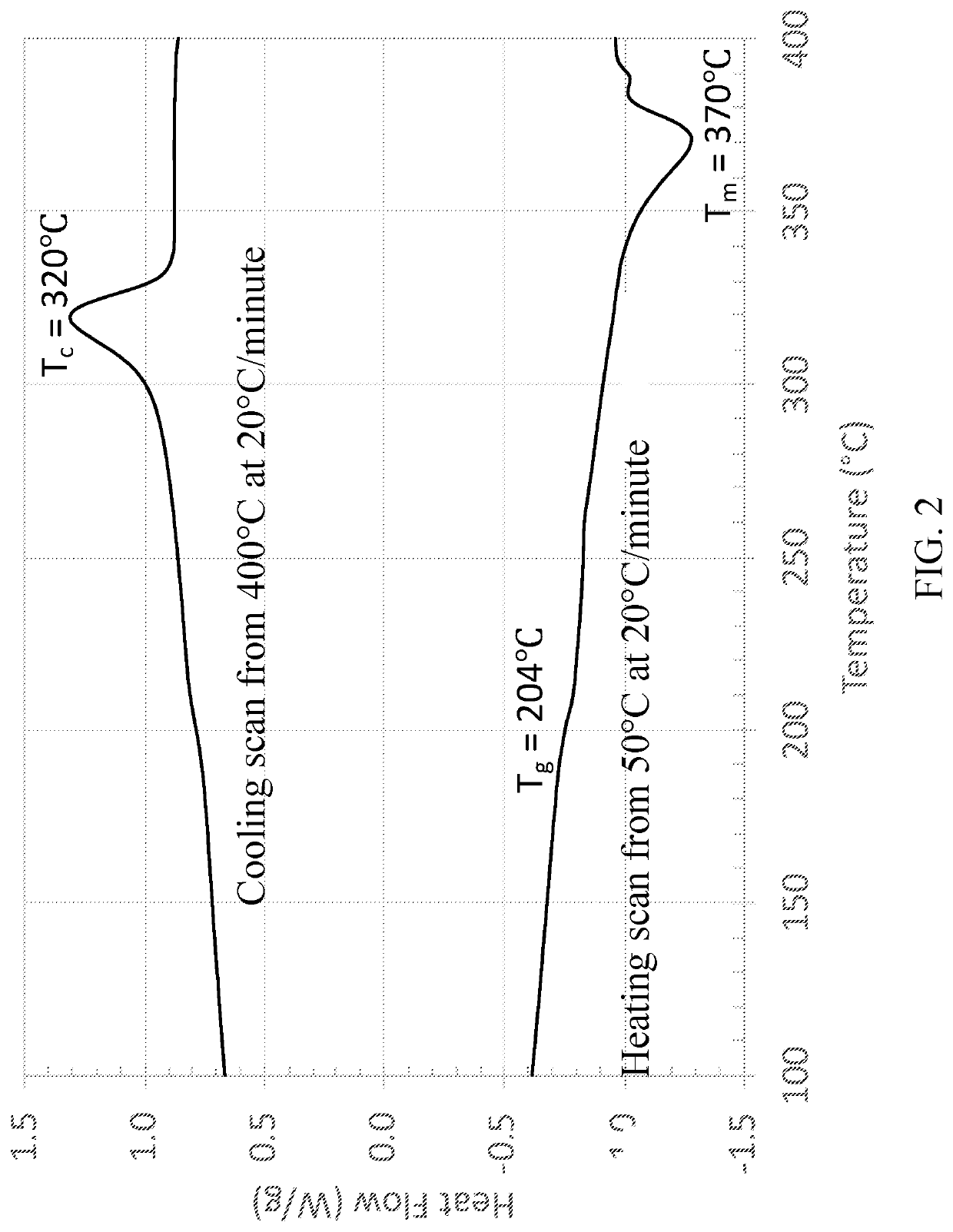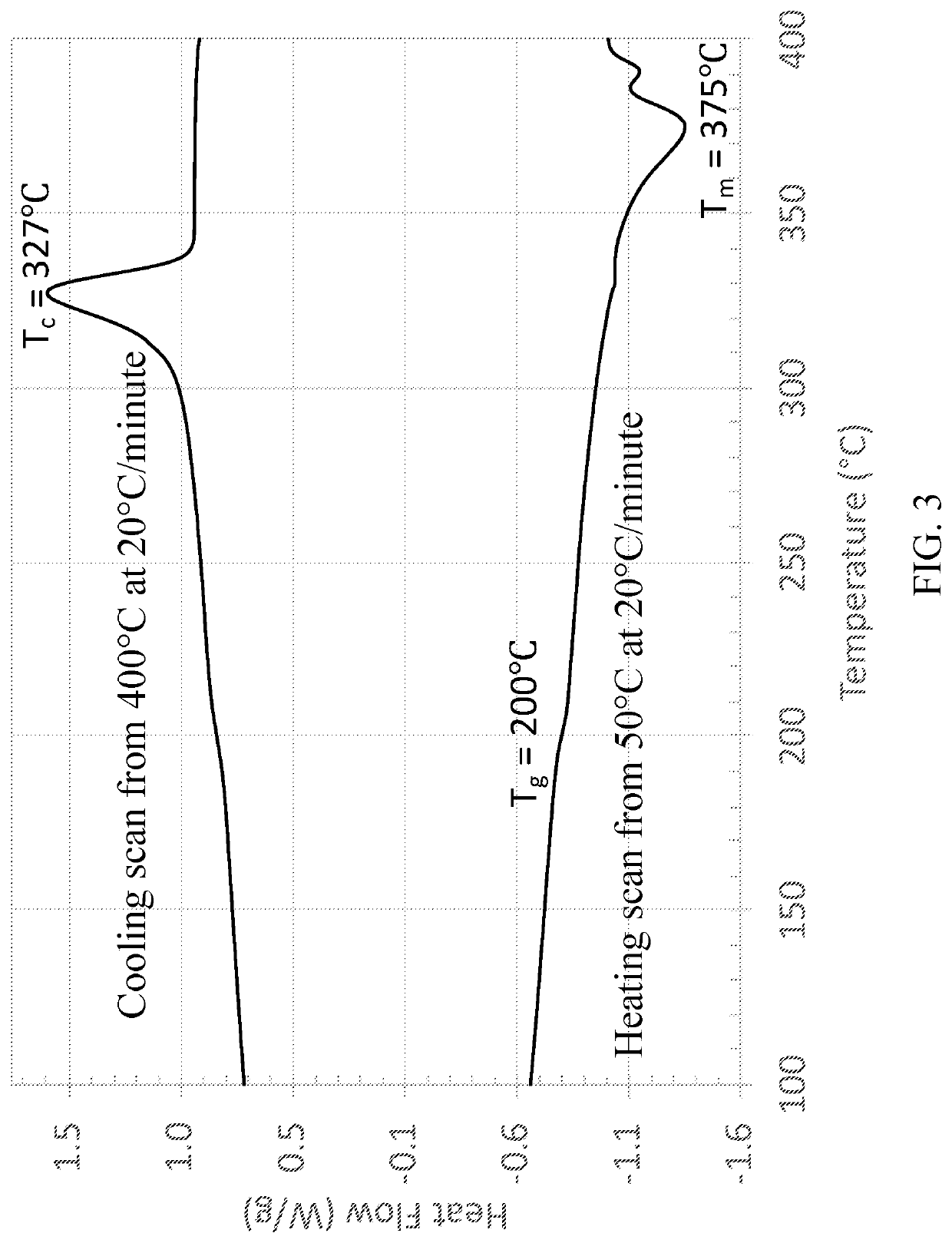High Temperature Semicrystalline Poly(aryl ether ketone) Copolymers
a technology of aryl ether ketone and semicrystalline polymer, which is applied in the field of semicrystalline poly (aryl ether ketone) copolymer, can solve the problems of excessively high melting temperature, and limiting its ability to withstand continuous operations. , to achieve the effect of improving crystallinity, chemical resistance and improving performan
- Summary
- Abstract
- Description
- Claims
- Application Information
AI Technical Summary
Benefits of technology
Problems solved by technology
Method used
Image
Examples
examples
[0078]The following examples are illustrative of the practice of the present invention and are not intended in any way to limit their scope.
[0079]Copolymers from 4,4′-biphenol and 2-benzimidazolinone with 4,4′-difluorobenzophenone
example 1
on of PAEK-1 Copolymer 29 / 71
[0088]In a 250 mL 3-neck reaction flask equipped with a mechanical stirrer, an argon inlet tube, a thermocouple plunging in the reaction medium, and a Dean-Stark trap with a condenser, were introduced 47.0 g of N-cyclohexyl-2-pyrrolidone (CHP), 1.40 g (10.46 mmol) of 2-benzimidazolinone, 5.48 g (39.66 mmol) of anhydrous potassium carbonate, 7.95 g (36.42 mmol) of 4,4′-difluorobenzophenone and 20 ml xylene. The flask content was evacuated under vacuum and then filled with high purity argon. The reaction mixture was then placed under a constant argon purge (40 mL / min).
[0089]The reaction mixture was heated slowly to 155° C. and kept at 155° C. for 30 minutes. The reaction mixture was then heated to 175° C. and kept 175° C. for 60 minutes. During this process xylene along with water were distilled and collected in Dean-Stark trap and removed. The reaction mixture was then heated to 210° C. in 20 minutes and kept at 210° C. for 2 hours. During this process the...
example 2
on of PAEK-2 Copolymer 25.0 / 75.0
[0092]In a 250 mL 3-neck reaction flask equipped with a mechanical stirrer, an argon inlet tube, a thermocouple plunging in the reaction medium, and a Dean-Stark trap with a condenser, were introduced 47.0 g of N-cyclohexyl-2-pyrrolidone (CHP), 1.13 g (8.41 mmol) of 2-benzimidazolinone, 5.12 g (37.02 mmol) of anhydrous potassium carbonate, 7.42 g (33.99 mmol) of 4,4′-difluorobenzophenone and 20 ml xylene. The flask content was evacuated under vacuum and then filled with high purity argon. The reaction mixture was then placed under a constant argon purge (40 mL / min).
[0093]The reaction mixture was heated slowly to 155° C. and kept at 155° C. for 30 minutes. The reaction mixture was then heated to 175° C. and kept at 175° C. for 60 minutes. During this process xylene along with water were distilled and collected in Dean-Stark trap and removed. The reaction mixture was then heated to 210° C. in 20 minutes and kept at 210° C. for 1 hour. During this proces...
PUM
| Property | Measurement | Unit |
|---|---|---|
| enthalpy | aaaaa | aaaaa |
| enthalpy | aaaaa | aaaaa |
| Tm | aaaaa | aaaaa |
Abstract
Description
Claims
Application Information
 Login to View More
Login to View More - R&D
- Intellectual Property
- Life Sciences
- Materials
- Tech Scout
- Unparalleled Data Quality
- Higher Quality Content
- 60% Fewer Hallucinations
Browse by: Latest US Patents, China's latest patents, Technical Efficacy Thesaurus, Application Domain, Technology Topic, Popular Technical Reports.
© 2025 PatSnap. All rights reserved.Legal|Privacy policy|Modern Slavery Act Transparency Statement|Sitemap|About US| Contact US: help@patsnap.com



